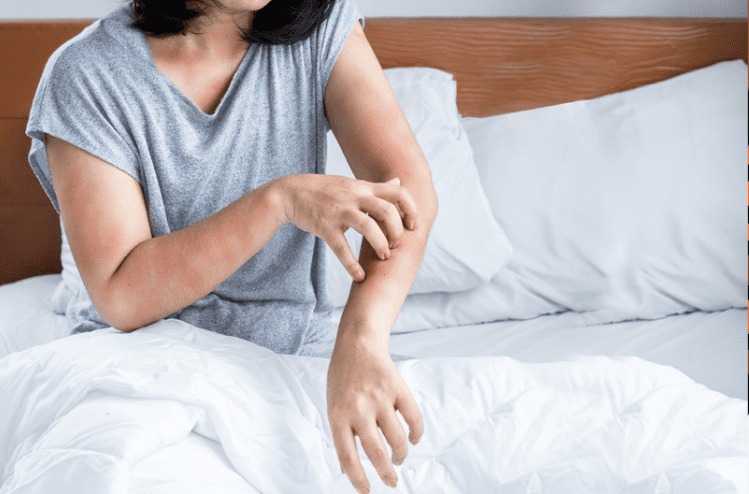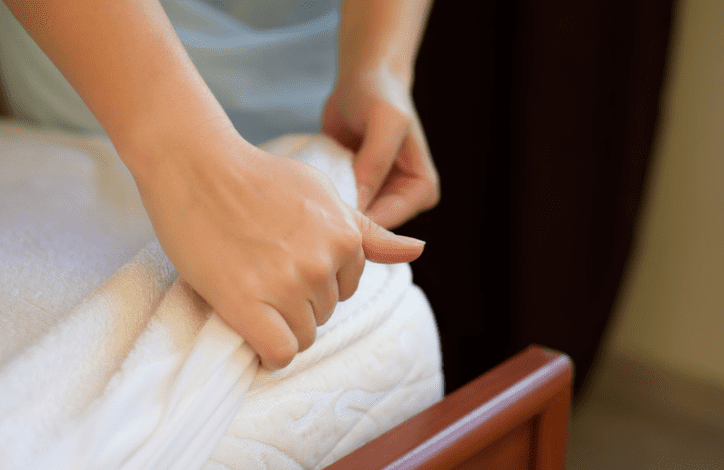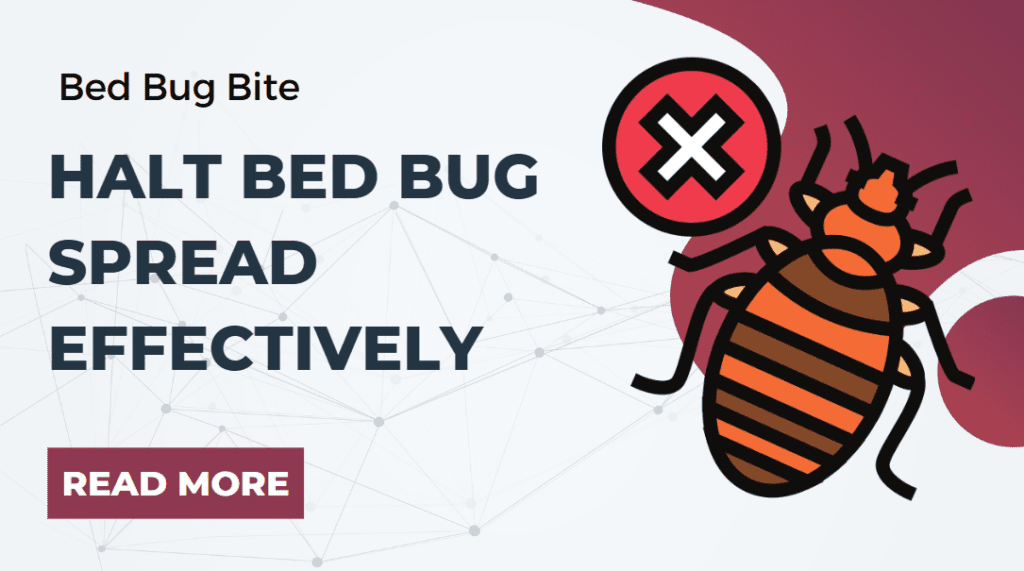Introduction: Understanding the Bed Bug Threat
Halt Bed Bug Spread Effectively. Bed bugs, small yet notorious pests, are a growing concern in households worldwide. These tiny, reddish-brown insects, known for their elusive behavior and penchant for feeding on human blood, often go unnoticed until an infestation is fully established. Early detection and intervention are crucial in combating these pests effectively. Understanding their habits and habitats is the first step in this battle. Bed bugs typically hide in mattresses, bed frames, and furniture, emerging at night to feed. Their bites, often painless at first, can lead to itchy, red welts, causing discomfort and stress. …Click Here to Continue Reading about Bed Bugs!

The rise in global travel and urban living has facilitated the rapid spread of bed bugs, making them a common yet challenging adversary. Contrary to popular belief, bed bugs are not drawn to dirt or filth; they are attracted to warmth, blood, and carbon dioxide, making any human environment ideal for their survival. These facts underscore the importance of staying vigilant and informed.
To understand more about their biology and behavior, the Environmental Protection Agency (EPA) offers in-depth insights. By visiting their page on bed bugs, you can gain a deeper understanding of these pests, which is essential for effective prevention and control. This knowledge empowers homeowners and tenants alike to take proactive steps in detecting and addressing bed bug infestations before they escalate into more significant problems.
As we delve deeper into this guide, you’ll learn not only how to identify signs of bed bugs but also the most effective strategies to halt their spread, ensuring your home remains a comfortable and pest-free environment.
Recognizing the Signs of a Bed Bug Infestation
Common Indicators: Bites, Sightings, and Other Signs
Identifying a bed bug infestation early can significantly reduce its impact and spread. The most common indicator of their presence is the appearance of bites. These bites often appear as small, red, itchy welts, typically in a line or cluster, and are most commonly found on areas of the body exposed while sleeping. However, not everyone reacts to bed bug bites, so it’s important to look for other signs.
Another clear sign of an infestation is seeing the bugs themselves. Adult bed bugs are about the size of an apple seed, reddish-brown, and oval-shaped. You may also find tiny, pale bed bug nymphs or their translucent shed skins. Additionally, look out for small, dark spots on bedding or mattresses, which could be bed bug excrement. A musty odor in your bedroom can also indicate a heavy infestation.
Tips for Thorough Inspection in Common and Hidden Areas
Conducting a thorough inspection is vital for early detection. Start by examining your bed: check the mattress, particularly seams and tags, and the bed frame, including cracks and joints. Don’t overlook furniture near the bed, such as nightstands and dressers. Bed bugs can also hide in less obvious places like wall hangings, electrical outlets, and even electronics.
For more comprehensive guidance on bed bug detection, the Centers for Disease Control and Prevention (CDC) provides valuable resources. Their guidelines on identifying and inspecting for bed bugs offer practical advice to ensure a thorough search. Remember, finding bed bugs early can make all the difference in effectively managing an infestation.
In the next sections, we will explore the immediate steps you can take to contain and ultimately stop the spread of bed bugs, ensuring your home returns to being a safe and peaceful environment.
Immediate Steps to Contain Bed Bugs
Isolating Affected Areas and Items
As soon as you detect a bed bug infestation, swift action is crucial. Begin by isolating the affected area to prevent the bed bugs from spreading to other parts of your home. This means temporarily avoiding sleeping or sitting in infested rooms when possible. If relocation within your home isn’t feasible, consider using bed bug-proof encasements on your mattress and pillows to trap the bugs.
Remove all bedding, curtains, and clothing from the affected area and seal them in plastic bags. This will contain any bed bugs present and prevent them from moving to other areas. Before washing, carefully transport these items to the laundry to avoid spreading the infestation along the way.
Initial Cleaning Measures: Vacuuming and Laundering
Vacuuming plays a vital role in bed bug control. Use a vacuum cleaner with a hose attachment to thoroughly clean the seams of mattresses, bed frames, furniture, and baseboards. Immediately after vacuuming, seal and dispose of the vacuum bag in an outside trash bin.
Laundering is another effective method. Wash all fabric items (bedding, clothes, curtains) in hot water and dry them on the highest dryer setting. High temperatures kill bed bugs in all stages of development. For items that cannot be washed, consider using a clothes dryer, dry cleaning, or professional heat treatment.
Importance of Avoiding Spread to Unaffected Areas
During the cleaning and treatment process, it’s crucial to prevent the spread of bed bugs to unaffected areas. This includes being mindful of where you place cleaned and treated items. Store them in sealed plastic bags until the infestation is completely eradicated. Also, avoid moving furniture or personal items from the infested area to other parts of your home.
The University of Minnesota offers comprehensive guidelines on bed bug management in homes. Their strategies emphasize early detection and immediate containment to prevent further spread. By implementing these targeted actions, you can significantly reduce the extent of the infestation and pave the way for successful elimination of these persistent pests.
In the following sections, we will discuss long-term prevention strategies and delve into both chemical and non-chemical treatment options to provide a multifaceted approach to bed bug eradication.
Long-Term Prevention Strategies
Regular Inspection Routines
Maintaining a vigilant eye is key to preventing future bed bug infestations. Regular inspections should become a part of your routine, especially if you’ve experienced an infestation before. Check your sleeping areas periodically, focusing on the mattress seams, bed frames, and headboards. Extend these inspections to couches, chairs, and other soft furnishings, particularly those used frequently. Use a flashlight and a magnifying glass to aid in spotting any early signs of bed bugs.
Best Practices in Household Cleanliness and Clutter Management
A clutter-free environment reduces the number of places bed bugs can hide and makes it easier to spot an infestation early. Regular cleaning, including vacuuming floors and furniture, can help prevent bed bugs from establishing a foothold. While cleanliness alone won’t prevent bed bugs, it is an important part of an integrated pest management approach.
Managing clutter is also crucial. Reduce the number of hiding places for bed bugs by minimizing clutter around your bed and in your bedroom. Store items in plastic bins rather than cardboard boxes, as plastic is less hospitable to bed bugs and easier to inspect.
Travel Tips: Preventing Bed Bugs from Hitchhiking Home
Travel is a common way bed bugs spread. When staying in hotels or guest houses, inspect the bed, headboard, and furniture for signs of bed bugs. Keep your luggage on a luggage rack away from the bed and walls. Upon returning home, inspect and vacuum your luggage before bringing it inside. Wash all clothes from your trip in hot water and dry on a high heat setting, regardless of whether you wore them.
The Environmental Protection Agency (EPA) provides detailed information on bed bug prevention, especially while traveling. Their recommendations can help you take proactive steps to ensure you don’t inadvertently bring bed bugs home from your travels.
Implementing these long-term prevention strategies can significantly reduce the risk of bed bug infestations in your home. In the next sections, we will explore the various treatment options available, including both chemical and non-chemical methods, to provide you with a comprehensive approach to tackling any bed bug problem.
Chemical and Non-Chemical Treatment Options
Overview of Available Chemical Treatments: Pros and Cons
Chemical treatments are a common method for combating bed bug infestations. These typically include insecticides in the form of sprays, powders, or aerosols. The key is to select products specifically designed for bed bugs, ensuring they are both effective and safe for indoor use. While chemical treatments can be powerful, they often require multiple applications and may not be effective against pesticide-resistant bed bugs. It’s also crucial to use these products correctly to avoid health risks.
For detailed guidance on the safe and effective use of bed bug insecticides, the National Pesticide Information Center provides a wealth of information. Their resources can help you make informed decisions about chemical treatments and understand their potential impact.
Exploring Non-Chemical Methods: Heat Treatment, Freezing, etc.
Non-chemical methods offer an alternative or supplementary approach to bed bug control. Heat treatment is one of the most effective non-chemical methods. This involves raising the temperature in the affected area to a level that is lethal for bed bugs at all life stages. Professional exterminators typically perform this treatment, as it requires specialized equipment to achieve and maintain the necessary temperatures.
Freezing is another option, although it requires extended exposure to very low temperatures, which may not be feasible for large items or in certain environments. Other non-chemical methods include steam treatments and vacuuming, both of which can be effective when used correctly and thoroughly.
Hiring a Professional Exterminator: When and Why
In many cases, particularly with severe or persistent infestations, hiring a professional exterminator is the most effective course of action. Professionals have access to a range of tools and methods, both chemical and non-chemical, and have the expertise to use them safely and effectively. They can also provide customized solutions based on the specific circumstances of your infestation.
The decision to hire a professional should be based on the severity of the infestation, the size of the affected area, and your comfort level with using chemical treatments. The EPA’s website offers insights into selecting a qualified pest control professional and what to expect from their services.
In the following sections, we will examine the efficacy of DIY remedies and their potential risks, as well as provide guidance on aftercare to ensure bed bugs do not return.
DIY Remedies: Do They Work?
Common Home Remedies for Bed Bugs: Effectiveness and Risks
Do-it-yourself (DIY) remedies for bed bugs have gained popularity, but it’s essential to evaluate their effectiveness and risks. Common DIY methods include using diatomaceous earth, baking soda, or essential oils like tea tree or lavender oil. While these remedies may offer some level of bed bug repulsion or kill them on contact, their overall effectiveness in eradicating an infestation is limited. They often fail to reach the deeper hiding spots where bed bugs thrive.
Moreover, the misuse of these substances can pose health risks, especially when used in large quantities or inappropriately. Diatomaceous earth, for example, can be harmful if inhaled. It’s crucial to research and follow safety guidelines when considering any home remedy.
Myth-busting: Separating Fact from Fiction in Bed Bug Control
There are numerous myths surrounding bed bug control. One common misconception is that bed bugs can be eradicated by turning up the heat in your home or using ultrasonic devices. However, these methods are ineffective. Bed bugs can survive a wide range of temperatures, and there is no scientific evidence supporting the effectiveness of ultrasonic devices against bed bugs.
It’s vital to base your bed bug control methods on scientifically backed information. The University of Kentucky’s entomology department provides reliable information debunking common bed bug myths and highlighting effective control strategies. Understanding what truly works is key to effectively managing a bed bug situation.
In our next section, we’ll discuss aftercare strategies to ensure your efforts in combating bed bugs are long-lasting and that these persistent pests do not make a comeback in your home.
Aftercare: Ensuring Bed Bugs Don’t Return
Monitoring Post-Treatment: Signs of Recurrence
After completing bed bug treatment, whether DIY or professional, continuous monitoring is crucial to ensure the pests don’t return. Regularly inspect your sleeping areas, focusing on the mattress, bed frame, and nearby furniture. Look for signs of recurrence, like new bites, live bed bugs, shed skins, or fecal spots. Using bed bug interceptors under bed legs can also help detect their return. These tools trap bed bugs trying to climb up the bed, serving as an early warning system.
Long-Term Preventive Measures

Prevention is the most effective strategy against bed bug recurrence. Maintain a clutter-free environment to minimize hiding places. Regular vacuuming can help remove any stray bugs or eggs. Consider applying bed bug-proof mattress encasements, which not only trap any remaining bed bugs but also prevent new ones from infesting your mattress. Be cautious when bringing second-hand furniture into your home, as it can be a common source of bed bugs.
Additionally, stay informed about bed bug prevention techniques. The National Pest Management Association offers updated information and tips on preventing bed bug infestations, helping you stay one step ahead of these pests.
Creating a Bed Bug-Resistant Environment
Modifying your environment can further reduce the likelihood of bed bug infestations. Opt for light-colored bedding to make spotting bed bugs easier. Seal cracks and crevices in walls, baseboards, and electrical outlets to eliminate potential hiding spots. Consider using bed bug monitors or traps as part of your regular pest control routine.
By combining these aftercare and preventive measures, you can create a living space that is less inviting to bed bugs. This holistic approach, from early detection to long-term prevention, is your best defense against future bed bug problems. In our concluding section, we will recap the key strategies and provide additional resources for effective bed bug control, ensuring your home remains a comfortable and pest-free environment.
Conclusion: Empowering Yourself Against Bed Bugs
In conclusion, effectively stopping the spread of bed bugs requires a combination of awareness, prompt action, and ongoing vigilance. From recognizing the early signs of an infestation to employing both immediate containment strategies and long-term preventive measures, every step is crucial in maintaining a bed bug-free home. Whether opting for DIY methods, chemical treatments, or professional extermination, understanding and choosing the right approach for your situation is key.
Recap of Key Strategies to Stop Bed Bug Spread
Remember, early detection through regular inspection is your first line of defense. Employing immediate containment measures like vacuuming, laundering, and isolating affected areas can significantly reduce the spread. Long-term strategies, including maintaining cleanliness, minimizing clutter, and being cautious during travel, are essential in preventing reinfestation. And, in cases of severe infestations, don’t hesitate to consult a professional for effective eradication.
Encouragement for Consistent Prevention Efforts
Staying informed and proactive is the best way to ensure your home remains a sanctuary, free from bed bugs. Regularly updating yourself on bed bug control methods and adapting your strategies as needed can make all the difference. Your efforts in creating and maintaining a bed bug-resistant environment are not just about pest control; they’re about safeguarding the comfort and health of your living space.
Resources for Further Reading and Assistance
For additional resources and guidance, websites like the Environmental Protection Agency (EPA) and the Centers for Disease Control and Prevention (CDC) offer comprehensive information on bed bug identification, treatment, and prevention. These resources can provide you with the latest insights and techniques in bed bug management, equipping you with the knowledge to tackle any bed bug challenge effectively.
By following these guidelines and utilizing available resources, you can confidently manage and prevent bed bug infestations. Your commitment to learning and applying these strategies will ensure that bed bugs don’t stand a chance in your home, helping you maintain a peaceful and comfortable living environment.




